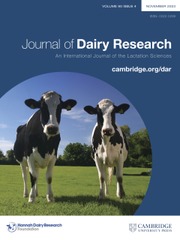Crossref Citations
This article has been cited by the following publications. This list is generated based on data provided by
Crossref.
Sarikaya, H.
and
Bruckmaier, R.M.
2006.
Importance of the Sampled Milk Fraction for the Prediction of Total Quarter Somatic Cell Count.
Journal of Dairy Science,
Vol. 89,
Issue. 11,
p.
4246.
Rovai, M.
Kollmann, M.T.
and
Bruckmaier, R.M.
2007.
Incontinentia Lactis: Physiology and Anatomy Conducive to Milk Leakage in Dairy Cows.
Journal of Dairy Science,
Vol. 90,
Issue. 2,
p.
682.
Tančin, V.
Uhrinčať, M.
Mačuhová, L.
and
Bruckmaier, R.M.
2007.
Effect of pre-stimulation on milk flow pattern and distribution of milk constituents at a quarter level.
Czech Journal of Animal Science,
Vol. 52,
Issue. 5,
p.
117.
Werner-Misof, C.
Macuhova, J.
Tancin, V.
and
Bruckmaier, R.M.
2007.
Dose dependent changes in inflammatory parameters in the milk of dairy cows after intramammary infusion of lipopolysaccharide.
Veterinární medicína,
Vol. 52,
Issue. 3,
p.
95.
Capote, J.
Castro, N.
Caja, G.
Fernández, G.
Briggs, H.
and
Argüello, A.
2008.
Effects of the frequency of milking and lactation stage on milk fractions and milk composition in Tinerfeña dairy goats.
Small Ruminant Research,
Vol. 75,
Issue. 2-3,
p.
252.
Cormican, Paul
Meade, Kieran G.
Cahalane, Sarah
Narciandi, Fernando
Chapwanya, Aspinas
Lloyd, Andrew T.
and
O’Farrelly, Cliona
2008.
Evolution, expression and effectiveness in a cluster of novel bovine β-defensins.
Immunogenetics,
Vol. 60,
Issue. 3-4,
p.
147.
Wellnitz, Olga
Doherr, Marcus G
Woloszyn, Marta
and
Bruckmaier, Rupert M
2009.
Prediction of total quarter milk somatic cell counts based on foremilk sampling.
Journal of Dairy Research,
Vol. 76,
Issue. 3,
p.
326.
STOCKLER, R. M.
MORIN, D. E.
LANTZ, R. K.
HURLEY, W. L.
and
CONSTABLE, P. D.
2009.
Effect of milk fraction on concentrations of cephapirin and desacetylcephapirin in bovine milk after intramammary infusion of cephapirin sodium.
Journal of Veterinary Pharmacology and Therapeutics,
Vol. 32,
Issue. 4,
p.
345.
Baumert, Amandine
Bruckmaier, Rupert M.
and
Wellnitz, Olga
2009.
Cell population, viability, and some key immunomodulatory molecules in different milk somatic cell samples in dairy cows.
Journal of Dairy Research,
Vol. 76,
Issue. 3,
p.
356.
Wellnitz, Olga
Baumert, Amandine
Saudenowa, Machabbat
and
Bruckmaier, Rupert M
2010.
Immune response of bovine milk somatic cells to endotoxin in healthy quarters with normal and very low cell counts.
Journal of Dairy Research,
Vol. 77,
Issue. 4,
p.
452.
Schwarz, Daniel
Diesterbeck, Ulrike S
König, Sven
Brügemann, Kerstin
Schlez, Karen
Zschöck, Michael
Wolter, Wilfried
and
Czerny, Claus-Peter
2011.
Microscopic differential cell counts in milk for the evaluation of inflammatory reactions in clinically healthy and subclinically infected bovine mammary glands.
Journal of Dairy Research,
Vol. 78,
Issue. 4,
p.
448.
Pilla, R.
Schwarz, D.
König, S.
and
Piccinini, R.
2012.
Microscopic differential cell counting to identify inflammatory reactions in dairy cow quarter milk samples.
Journal of Dairy Science,
Vol. 95,
Issue. 8,
p.
4410.
Vetter, A.
Argüello, A.
Baumrucker, C.
and
Bruckmaier, R.M.
2013.
Short communication: Fractional milking distribution of immunoglobulin G and other constituents in colostrum.
Journal of Dairy Science,
Vol. 96,
Issue. 9,
p.
5919.
Blagitz, Maiara G
Souza, Fernando N
Batista, Camila F
Azevedo, Luis Fernando F
Benites, Nilson Roberti
Melville, Priscilla Anne
Diniz, Soraia A
Silva, Marcos X
Haddad, João Paulo A
Heinnemann, Marcos Bryan
Cerqueira, Mônica M O P
and
Della Libera, Alice M M P
2015.
The neutrophil function and lymphocyte profile of milk from bovine mammary glands infected with Streptococcus dysgalactiae.
Journal of Dairy Research,
Vol. 82,
Issue. 4,
p.
460.
Fouz, Ramiro
Vilar, María J.
Yus, Eduardo
Sanjuán, María-Luisa
and
Diéguez, Francisco J.
2016.
Short communication: Influence of the sampling device on somatic cell count variation in cow milk samples (by official recording).
Spanish Journal of Agricultural Research,
Vol. 14,
Issue. 1,
p.
e05SC01.
Damm, Malin
Holm, Claus
Blaabjerg, Mette
Bro, Morten Novak
and
Schwarz, Daniel
2017.
Differential somatic cell count—A novel method for routine mastitis screening in the frame of Dairy Herd Improvement testing programs.
Journal of Dairy Science,
Vol. 100,
Issue. 6,
p.
4926.
Cozma, A.
Martin, B.
Cirié, C.
Verdier‐Metz, I.
Agabriel, J.
and
Ferlay, A.
2017.
Influence of the calf presence during milking on dairy performance, milk fatty acid composition, lipolysis and cheese composition in Salers cows during winter and grazing seasons.
Journal of Animal Physiology and Animal Nutrition,
Vol. 101,
Issue. 5,
p.
949.
Herve, L.
Quesnel, H.
Lollivier, V.
Portanguen, J.
Bruckmaier, R.M.
and
Boutinaud, M.
2017.
Mammary epithelium disruption and mammary epithelial cell exfoliation during milking in dairy cows.
Journal of Dairy Science,
Vol. 100,
Issue. 12,
p.
9824.
Dan, Denisa
Bruckmaier, Rupert M.
and
Wellnitz, Olga
2018.
Ketoprofen affects the mammary immune response in dairy cows in vivo and in vitro.
Journal of Dairy Science,
Vol. 101,
Issue. 12,
p.
11321.
Wall, Samantha K.
Wellnitz, Olga
Bruckmaier, Rupert M.
and
Schwarz, Daniel
2018.
Differential somatic cell count in milk before, during, and after lipopolysaccharide- and lipoteichoic-acid-induced mastitis in dairy cows.
Journal of Dairy Science,
Vol. 101,
Issue. 6,
p.
5362.




